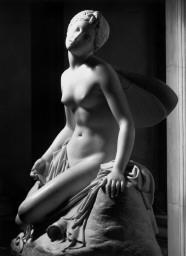The ties between renowned Italian sculptor Antonio Canova and international neoclassical art are the focus of an upcoming exhibition in the western Italian city of Forli'.
Canova (1757-1822) was born in the Veneto region and spent most of his adult life in Rome but his impact on neoclassical art was widespread.
The exhibition takes three key sculptures linked to Forli' as a springboard for exploring Canova's influence on other painters and sculptors through 160 artworks.
A sculpture of Hebe, goddess of youth and daughter of Hera, is the first of the three works.
Commissioned by the Countess Veronica Guarini, the statue was completed between 1816 and 1817 and is today one of Canova's best known works.
For many art historians, it epitomizes his skill at transferring the sense of movement common in painting into sculpture.
The marble statue shows Hebe as cupbearer of the gods balancing a goblet with ambrosia but the skill of the piece lies in the flapping folds of her dress, as she gracefully steps forward.
This first section of the exhibit will include two sculptures from ancient time designed to highlight inspiration Canova drew from classical works.
There are also numerous paintings depicting Hebe from a variety of international and Italian artists.
Dance is the focus of the second section, inspired by Canova's sculpture, Dancer with Finger on Chin. Created between 1809 and 1814 for a local banker, Domenico Manzoni, the work went missing following a break-in during which Mazoni was killed.
Although never recovered, the original is today known through a beautiful plaster model by Canova and an accurate marble copy by another sculptor, Luigi Bienaime.
An extraordinary series of drawings and tempera works by Canova reveal the artist's less known talents as a painter.
The final section, entitled 'Sculptor Philosopher', opens with a Canova statue of Orpheus on loan from the Hermitage.
It investigates how Canova explored the metaphysical subject of death and centres on the marble funerary monument he created for the murdered banker, inspired by classical Roman designs.
This section compares Canova's interpretations with similar paintings and his experiments with bas-relief carvings, particularly a dramatic series showing the final hours of Socrates.
Elsewhere, the show includes Canova's stunning masterpiece of Cupid and Psyche, surrounded by other interpretations of the mythological lovers, by painters such as Angelica Kauffmann and Francesco Hayez.
Another section explores the relationship between Canova and the two great popes of the neoclassical age, Pius VI and his successor Pius VII, both of whom from Cesena, a town near Forli.
The exhibition opens in Forli's San Domenico Museum on January 25 and runs until June 21.




